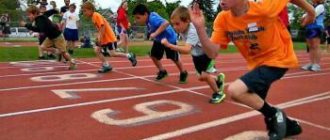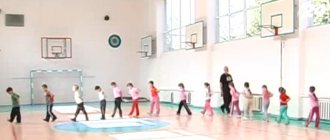Presentation "Athletics"
Athletics
is an Olympic sport that includes running, walking, jumping and throwing. Combines the following disciplines: cross-country events, race walking, technical events (jumping and throwing), all-around events, runs (road running) and cross-country (cross-country running). One of the main and most popular sports.
Athletics
– one of the most popular sports, to say the least. After all, in wide circles of sports fans she bears the title – Queen of Sports.
History of the development of athletics
The history of athletics dates back to the Olympic Games in Ancient Greece. Their program then consisted mainly of track and field events. At the very first Olympics, people competed only in the stadium length race (192.27 m). Later, diaulos appeared in the program - running in two stages (there and back). Then came the endurance running – dolichodromos.
History of the development of athletics
In 708 BC. The athletes were already competing in the pentathlon (pentathlon), and later in the lampaderiomas, a relay race in which participants passed a burning torch to each other.
History of the development of athletics
Athletics are believed to have been very popular in the British Isles. From the 12th century competitions began to be held there in running over various distances, long jumps, high jumps, pole jumps, and weight throwing. These competitions formed the basis of most types of modern athletics.
History of the development of athletics
Athletics was reborn in 1859, when the Greeks tried to revive the Olympic Games. Athletics took the main place in the program of the first national competitions. In 1866, the first British athletics championship was held, and 10 years later a similar competition was held in the USA. Athletics appeared in Russia in 1888.
History of the development of athletics
Since 1946 owls track and field athletes participate in the European Championships (held since 1934 in even-numbered years between the Olympic Games), and since 1952 in the Olympic Games.
The European Athletics Association was founded in 1968. - EAA, uniting 35 national federations
Organization
The highest governing body regulating the conduct of competitions and the development of athletics as a sport is: the International Association of Athletics Federations (IAAF).
The IAAF determines the international rules for competitions and maintains the world ranking of leading track and field athletes.
Types of athletics
- Walking
- Run
- Jumping
- Throwing
- All-around
SPORT WALKING
- This is an alternation of steps performed in such a way that the athlete is constantly in contact with the ground, and at the same time there is no loss of contact visible to the human eye. The forward (supporting) leg must be fully straightened (i.e., not bent at the knee) from the moment of first contact with the ground until it passes the vertical.
RUN
– the most common type of physical exercise, which is an integral part of many sports, as well as various sports and physical education complexes. There are the following types of running:
Smooth
- carried out on a treadmill in a circle (counterclockwise) for various distances and/or for a time. in turn is divided into:
- Smooth
- carried out on a treadmill in a circle (counterclockwise) for various distances and/or for a time. in turn is divided into:
sprinting
(sprint) - the length of the sprint distance does not exceed 400 meters.
middle distance running
(Mittelstrecker) - distances from 600 to 2000 meters.
long distance running
(stayer) - distances from 2000 meters.
- short distance running
(sprint) - the length of the sprint distance does not exceed 400 meters.
middle distance running
(Mittelstrecker) - distances from 600 to 2000 meters.
long-distance running
(stayer) - distances from 2000 meters. - short distance running
(sprint) - the length of the sprint distance does not exceed 400 meters.
middle distance running
(Mittelstrecker) - distances from 600 to 2000 meters.
long-distance running
(stayer) - distances from 2000 meters.
With obstacles
- a set of athletics disciplines where athletes compete at distances in which it is necessary to overcome barriers. Divided into:
- Steeplechase
is a set of athletics disciplines where athletes compete at distances in which it is necessary to overcome barriers. Divided into:
running with obstacles
at a distance of 3000 meters (steeple chase).
hurdles
at sprint distances.
- steeplechase
over a distance of 3000 meters (steeplechase).
hurdles
at sprint distances. - steeplechase
over a distance of 3000 meters (steeplechase).
hurdles
at sprint distances.
Running in natural conditions over rough terrain
(cross).
Relay
- a set of team sports disciplines in which participants go through stages one after another, passing each other their turn to move along the distance.
- Running in natural conditions over rough terrain
(cross).
Relay
is a set of team sports disciplines in which participants go through stages one after another, passing each other their turn to move along the distance.
RUNNING JUMPS
are
divided into:
Vertical jumps
- high jump, pole vault.
Horizontal jumps
- long jump, triple jump.
- Vertical jumps
- high jump, pole vault.
Horizontal jumps
- long jump, triple jump.
Throwing
-
A complex of sports disciplines in athletics, including:
Discus throw
Hammer throwing
Javelin-throwing
Shot put
- Discus throw Hammer throw Javelin throw Shot put








